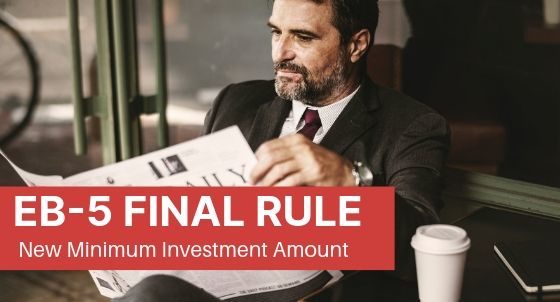The EB-5 immigrant investor visa program was created by Congress in 1990 to allow foreign nationals acquire permanent residence or citizenship by investing a substantial amount of money into the United States economy. Over the past two years, the Department of Homeland Security (DHS), the agency overseeing the investment program, has been working behind the scenes to redefine the rules guiding the program.
The final rule was eventually published on July 24, 2019 by the DHS. It is the most significant change to the program since its inception in 1990. An overview of the major aspects of the EB-5 final rule, set to become effective by November 21, 2019, can be seen at a glance below:
- The minimum investment amount will be $900,000 for Targeted Employment Area (TEA) projects and $1.8 million for non-TEA projects
- Designation of the Targeted Employment Areas will exclusively be done by USCIS rather than the individual states.
- The original priority dates will be retained by investors for subsequent EB-5 petitions.
- An improved adjudication procedure for the removal of conditions on permanent residence.
As expected, existing and prospective investors are keenly interested in the details of these changes. This article gives you a breakdown of the EB-5 final rule.
EB-5 Minimum Investment Amounts
Since its inception, the minimum investment amount for the EB-5 program has been $500,000 and $1 million for TEA and non-TEA designated investments respectively. However, as of the effective date of this final rule, the new EB-5 investment amount will be $900,000 for TEA and $1.8 million for non-TEA endeavors. Understandably, this is the most significant change to the regulations for foreign investors, which is why the USCIS had to reconsider its earlier proposed amount.
According to the Department of Homeland Security, the final rule would have had the TEA capital be 25% lower than the non-TEA amount, which would have meant $1.35 million for TEA investments. However, considering the review of comments from the public, the agency had to maintain the 50% difference between the two types of EB-5 investments.
Is the Increase in the EB-5 Minimum Amount Necessary?
Though many EB-5 foreign investors may be uncomfortable with the increase, from the perspective of the USCIS, it was a decision borne of sheer necessity. While the minimum amounts have remained the same for the past three decades, the same cannot be said of the inflation rate.
Several significant changes have occurred in the inflation rate since 1990, as indicated by the consumer price index (CPI). The increase, therefore, is to account for inflation and help fulfill the core congressional intent for creating the program, which was primarily to improve the U.S. economy.
The increased amount isn’t going to just make up for the inflation rate, but will also improve the performance of designated EB-5 regional centers. Fewer investors will now be needed by each center to pool the required amount of capital for a project. With this, it will be less costly and less demanding to search for and match investors for a project.
Targeted Employment Areas Designation Final Reforms
A targeted employment area (TEA) is a rural area or a location with a high unemployment rate, meaning at least 150% of the national average rate. Currently, investors are to demonstrate that their investments meet the definition of a TEA in two ways.
They can do so by providing evidence that the Metropolitan Statistical Area (MSA) where their businesses are located is a county or city with a population of 20,000 or more, and has experienced an average unemployment rate of at least 150%. The other way is to submit a letter from an authorized body of the state government where the business is located. The state can certify that their business is indeed located in an area that meets the definition of a TEA, and has been designated as a high unemployment area.
However, this is going to change. The proposed rule will eliminate state designation of high unemployment areas and also amend how investors can demonstrate that their investment is located in places with high unemployment rate. Instead, the designations would be made directly by the DHS based on the revised requirements. Cities and towns outside MSAs that have a population of 20,000 or more may be added based on high unemployment rate.
Impacts of the Final TEA Reforms
Although these reforms may cause some investments and projects to no longer qualify as being in a high unemployment area, it will help in increasing job growth in the targeted areas, consistent with the EB-5 program’s congressional intent. The new regulation will also restrict TEAs to the immediate environment of the EB-5 project, such as contiguous census tracts and adjacent areas.
Amendments on EB-5 Petition Priority Date
To ensure fairness in permanent residence issuance to all eligible foreign nationals, the Immigration and Nationality Act had to set a numerical limit for each country using the priority date initiative. This requires applicants from the same country to take turns in the visa waiting line.
A priority date is the date that the USCIS receives an immigrant investor’s EB-5 petition to participate in the program. It is your place on the green card queue and will have to become ‘current’, meaning you have reached the front of the queue and a visa number has become available to you. This is why the processing time can sometimes last for years, especially for nationals from countries with multi-year immigrant visa backlogs.
However, with the proposed rule, EB-5 applicants will be allowed to retain their first priority date and use it for subsequently filed petitions. Unless the petition is canceled by the DHS for a material error, fraud, or willful misrepresentation by the petitioner, the first date will remain valid.
If circumstances, such as termination of a regional center, a material change, or other situations that are beyond your control, require that you file another EB-5 petition, you will be able to do that using the same priority date given for the first petition.
The adopted changes will make visa allocation more predictable and reduce fluctuations in visa availability dates. Immigrant investors will also spend less time waiting for their visas. It will also make the program more flexible for investors, allow them to contribute to more viable investments, curb fraud, and improve job creation.
Procedures for Removal of Conditions on Permanent Residence
Additionally, the revision will address the technical issues affecting how EB-5 derivatives file an I-829 petition, a process which the existing regulation does not clearly define. The final rule will make the process flexible by determining the interview location and amend the regulation by which investors obtain their new green card after the approval of their I-829 petition.
This will help eliminate the existing confusion faced by beneficiaries who file their petitions separately from principal petitioners. Also, the amendments in the interview location will give applicants more options, allowing them to travel shorter distances and saving both time and money.
EB-5 visa derivative family members whose names are not included in the petition can independently file a petition for the removal of conditions on their permanent residence. Those included in the principal investor’s petition will not be affected by this regulation. The new rule also clarifies the following:
- A child who is 21 and got married during the conditional permanent residence period may be included in the investor’s petition or file separately. The same applies to a former spouse who became divorced during the conditional permanent residence
- If the principal investor is deceased, the children and spouse may be included in one petition or file separately.
However, whether you are using a joint petition or filing separately, the general EB-5 requirements for removal condition must still be met, especially the provision or preservation of at least 10 U.S. jobs. The DHS also reiterated that failure to properly file and submit your petition for the removal of conditions within the 90 days preceding the second anniversary of the date it was issued, “shall result in the automatic termination” of your permanent resident status.
Will the Final Rule Affect the Number of EB-5 Visas Available Annually?
The new regulations will not reduce or increase the number of EB-5 visas per year. The numeric limit will still remain at 10,000 visas for eligible investors. However, the number of applicants may drop significantly due to the increased investment amount, which will mean less competition for those who meet all the eligibility criteria for the program.
The $900,000 or $1.8 million of required capital may become unaffordable to many foreign investors. This regulation might see many investors opting for investment programs offered by other countries other than the United States. But the overall congressional intent for EB-5 program will be more feasible.
What If I File My EB-5 Petition Before November 21, 2019?
The new regulations will not affect EB-5 petitions that are properly filed before the November 21, 2019 effective date. Therefore, you can still leverage the existing EB-5 regulations by obtaining the required investment amount and filing your I-526 as soon as possible.
While doing that, ensure that you submit your petition with all the necessary supporting evidence, which may subject your application to a request for evidence (RFE) down the line. While you are still allowed to enjoy the current rules, you should keep in mind that petitions with little or no evidence that appear as mere placeholders will likely be denied by the USCIS.
EB-5 experts have predicted an increase in the number of I-526 petitions that will be filed between now and the November effective date, as many people will want to take advantage of the existing rules. To this end, you will need to ensure thoroughness in your application process.
What Are the Current Guidelines for EB-5 Petition?
If you would like to leverage the current rules and reduce cost, the most effective guidelines for EB-5 petitions are as follows:
- Raise your investment capital of $500,000 or $1 million before the November effective date for the final rule.
- Consult an experienced EB-5 attorney to help you prepare your petition and complete the process.
- Find an EB-5 project to invest in.
- Prepare your EB-5 business plan.
- Put your capital “at-risk” by investing it in a project of your choice and submit your I-526 petition.
- Apply for a two-year conditional green card.
Does the Final Rule Affect the Existing EB-5 Investors?
While the adopted changes will mainly be felt by investors starting after November 21, the existing EB-5 participants are also concerned in the proposed review. Every 5 years, there will be adjustments to the investment amounts in line with the Consumer Price Index.
The review, however, should not have a major financial effect on existing investors. Also, the differential between the two investments types will not be affected, as the equivalency difference will remain at a 50% difference.
How VisaNation Law Group Immigration Attorneys Can Help
While the new EB-5 regulations may appear strict, the good news is that you still have four months to leverage the existing rules, especially the minimum investment amount. Keep in mind, however, that the four-month window will most likely witness an influx of EB-5 petitions.
This is why you need to engage an experienced EB-5 immigration attorney to help you file your petition properly with all the necessary evidence. Errors, either by omission or commission, can be detrimental to your application. This is where we can be of help.
VisaNation Law Group’s experienced EB-5 lawyers have many successful investor green card cases. They will help you prepare your petition and avoid RFEs so as to maximize the short window of opportunity and dramatically reduce the cost and time for your EB-5 green card process. Don’t wait, you can schedule a consultation with us today by filling out this contact form.
 Shilpa Malik
Shilpa Malik  Boris Ignachkov
Boris Ignachkov 